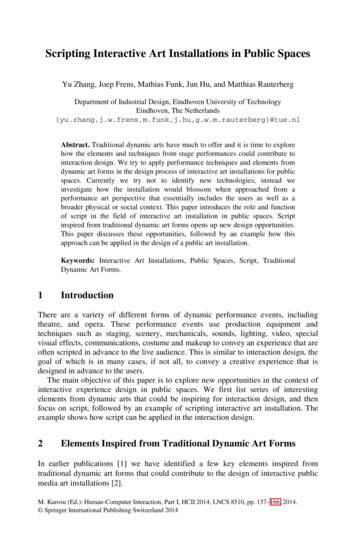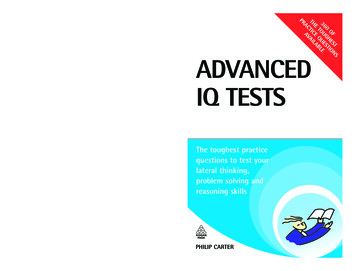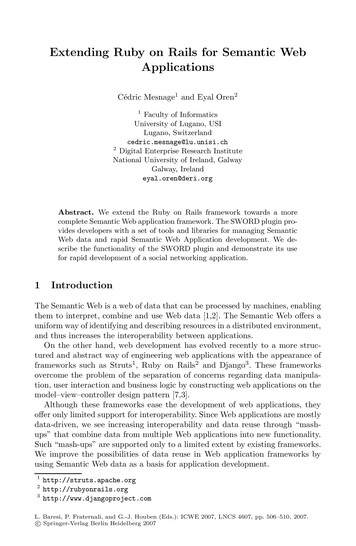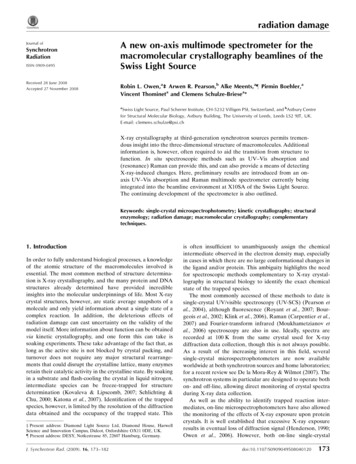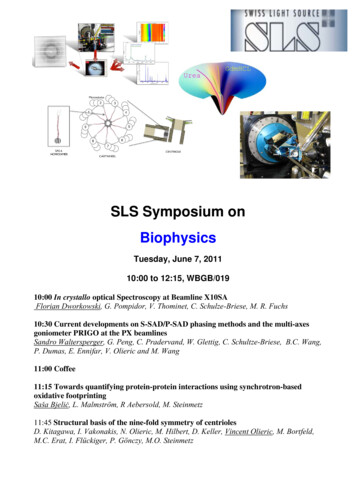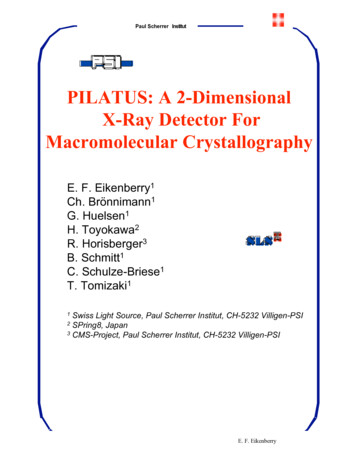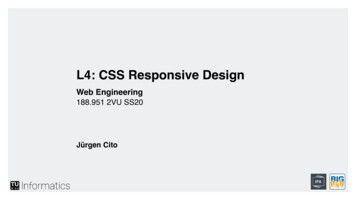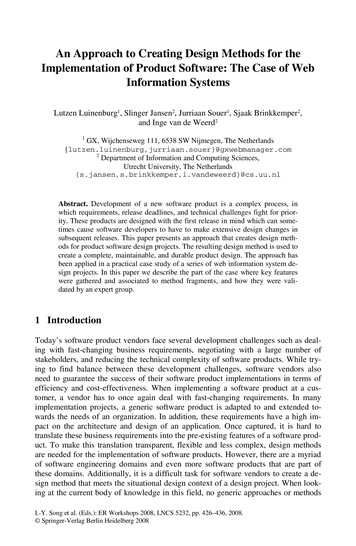
Transcription
An Approach to Creating Design Methods for theImplementation of Product Software: The Case of WebInformation SystemsLutzen Luinenburg1, Slinger Jansen2, Jurriaan Souer1, Sjaak Brinkkemper2,and Inge van de Weerd21GX, Wijchenseweg 111, 6538 SW Nijmegen, The bmanager.com2Department of Information and Computing Sciences,Utrecht University, The s.uu.nlAbstract. Development of a new software product is a complex process, inwhich requirements, release deadlines, and technical challenges fight for priority. These products are designed with the first release in mind which can sometimes cause software developers to have to make extensive design changes insubsequent releases. This paper presents an approach that creates design methods for product software design projects. The resulting design method is used tocreate a complete, maintainable, and durable product design. The approach hasbeen applied in a practical case study of a series of web information system design projects. In this paper we describe the part of the case where key featureswere gathered and associated to method fragments, and how they were validated by an expert group.1 IntroductionToday’s software product vendors face several development challenges such as dealing with fast-changing business requirements, negotiating with a large number ofstakeholders, and reducing the technical complexity of software products. While trying to find balance between these development challenges, software vendors alsoneed to guarantee the success of their software product implementations in terms ofefficiency and cost-effectiveness. When implementing a software product at a customer, a vendor has to once again deal with fast-changing requirements. In manyimplementation projects, a generic software product is adapted to and extended towards the needs of an organization. In addition, these requirements have a high impact on the architecture and design of an application. Once captured, it is hard totranslate these business requirements into the pre-existing features of a software product. To make this translation transparent, flexible and less complex, design methodsare needed for the implementation of software products. However, there are a myriadof software engineering domains and even more software products that are part ofthese domains. Additionally, it is a difficult task for software vendors to create a design method that meets the situational design context of a design project. When looking at the current body of knowledge in this field, no generic approaches or methodsI.-Y. Song et al. (Eds.): ER Workshops 2008, LNCS 5232, pp. 426–436, 2008. Springer-Verlag Berlin Heidelberg 2008
An Approach to Creating Design Methods for the Implementation of Product Software427exist to support product software design with the aim to create durable and maintainable product software designs during implementation projects.In this paper we propose an approach for design projects, using situational methodengineering. Situational method engineering has been applied successfully in severalcases and is an approach for finding the right method for an organization [1]. “Methodengineering is the engineering discipline to design, construct and adapt methods,techniques and tools for the development of information systems” [2]. A special typeof method engineering is situational method engineering which allows for creatingmethods that are tuned towards the unique development project situation [1, 20, 21].Assembly-based situational method engineering is an approach in which methodcomponents are extracted and stored in a method base driven by situational methodrequirements [14, 20]. A method fragment is a description of an IS (Information Systems) engineering method, or any coherent part thereof [10].The approach for design projects provides a guide in the selection and assembly ofsuitable method fragments into a product software design method. The approach helpsa method engineer to assemble a design method, deriving development project situations, storing relevant methods, and selecting the right method fragments based onproduct-related situational factors. We call this approach the Association and Assembly approach (AaAa).We continue this paper by presenting related work. In the third section we describethe AaA approach. Section 4 presents a WIS case and the derivation of key featuregroups. Section 5 provides an overview of key feature groups established in the WIScase. The last section presents some comments and conclusions.2 Creating the Association and Assembly ApproachCreating a design method that addresses every gathered functional requirement of asoftware product in a certain domain is complex. When looking at the domain of webengineering [6] many WIS design methods seem to be suitable for the design of dataintensive and process-intensive web applications. Examples of these methods are:OO-H [8], WebML [5], OOWS [13], Hera [22], and UWE [12]. However, thesemethods focus on web applications that are built from scratch without any preexisting components and ignore domains in which pre-existing components are usedto develop new applications. An example of a domain where pre-existing componentsare reused for new projects is the domain of Web Content Management Systems(WCMSs).The Association and Assembly approach (AaAa) consists of the following steps:1.2.3.4.5.6.Identify web engineering project situationsIdentify feature groupings of a software productSelect candidate methods for the identified feature groupingsModel relevant method fragments in a method baseAssociate feature groupings with candidate method conceptsAssemble situational web design method.
428L. Luinenburg et al.In order to address the fact that pre-existing components and functionality areavailable, we have adapted an existing assembly-based situational method engineering approach by adding two extra steps [20]. The first additional step (step 2) decomposes a software product into its main feature groups, in order to get more insight intoits key features and product characteristics. The second additional step (step 5) createsan association table wherein selected method fragments and software product featuregroups are formally compared.In the first step, development project situations can be specified by means of categorizing unique development project characteristics. Basically, different developmentsituations allow for the development of situational methods. For each developmentproject situation, specific project needs can be defined, such as applying UML formodeling since all developers have knowledge of this modeling language.Second, key feature groups of a software product domain are identified. These feature groups provide selection criteria for the assembly of a new method from a functional perspective.Third, the domain of the software product is determined and in that domain relevant candidate methods are selected. This can be done by means of a literature studywhich provides an overview of the available methods. For scoping and relevancypurposes, it is important to narrow down the list of candidate methods into a comprehensive set of methods by means of useful selection criteria (e.g. acceptance in thecommunity).Fourth, method fragments of the selected candidate methods are extracted andstored in a method base. A method base structures the method fragments and thuscaptures knowledge about engineering methods [10]. For a uniform specification ofall methods, a meta-modeling technique needs to be used which addresses the processas well the product perspective of a method [3].Fifth, the selected candidate methods are compared by means of positioning thefeature groups against the method fragments from a product perspective (e.g. deliverables in a meta-model) in an association table. This provides insight into which feature groups are addressed by the selected design methods. Next, it shows overlapbetween the methods in a way that a feature group is addressed by multiple methodfragments. The association table also shows which feature groups are partly or not atall addressed by a method fragment.In the final and sixth step, the results from the association table and the identifiedproject needs are input for the assembly process in order to create a situational designmethod for the implementation of a software product. To ensure that all selectedmethod fragments are assembled in a meaningful way, assembly guidelines should betaken into account. Brinkkemper et al. [3] have proposed logic rules for the assemblyof a meaningful method addressing five quality requirements, such as completeness,consistency, efficiency, applicability and reliability. Having knowledge about featuregroups allows a method engineer to analyze and select method fragments taking thefeature groups and functionalities into account.The final result of the AaA approach is a situational design method for the implementation of a software product taking the product’s feature groups and developmentproject situations into account. The resulting design method comprises of design activities and deliverables that allow for the translation of requirements into designedfeatures that are ready for development in the follow-up phase. For each development
An Approach to Creating Design Methods for the Implementation of Product Software429situation, a specific route map can be chosen that influences the type and number ofdesign deliverables produced during a project (step 1). Using this approach, a company can decide to use a more light-weight design approach for regular projects whichenables them to produce design deliverables in an efficient way.3 Derivation of Key Feature Groups in Practice: WIS CaseThe AaA approach has been validated by means of a case study. This case has beenperformed within GX, a Web Content Management software company. GX developsand implements its proprietary Web Content Management System called GX WebManager [19]. As part of the Web Engineering Method (WEM), a situational WCMSdesign method has been constructed. WEM is a web engineering approach for theimplementation of WCMSs and is consists of six traditional development phases:acquisition, orientation, definition, design, realization and implementation [17]. TheAaA approach is evaluated through an expert validation and validated by practicalprojects according to Yin [23].Souer et al. [17] positioned the term CMS-based web application which is a webapplication for the management and control of content. This type of web applicationcan be seen as a subtype of a web information system and a WCMS. In figure 1, theimplementation of AaA approach in a WCMS situation is depicted. In the first step,two development project situations have been defined, namely standard and complexdevelopment projects. Standard development projects were defined as developmentprojects that did not need any customization from a component perspective. Duringthe second step, fourteen key feature groups were identified.Web engineeringprojectsWCMS domain1. Identify project situations2. Identify featuregroupsExisting webmodelingmethods3. Select candidate methodsOO-H14 ethod5. Associate featuregroups with candidatemethods6. Assemble situationalweb design methodAssociationtableMethodbase4. Model candidate methodsSituationalWCMSdesignmethodFig. 1. The application of the Association and Assembly approach in a WIS case
430L. Luinenburg et al.These feature groups including the identification process are explained in the following sections. After the identification of feature groups, four mature WIS designmethods and a propriety design method were selected. Three main selection criteriawere applied: acceptance in the community, evolution of the approach and advancedtool support. In the fourth step, all relevant method fragments (e.g. requirements engineering, design and implementation fragments) were stored by means of using ameta-modeling technique called Process Deliverable Diagram (PDD) [20]. In total, 32method fragments have been stored.In step five, all candidate methods and key feature groups have been compared forselection purposes. During this association process it became clear that only threefeature groups were well addressed by all methods: site management, personalizationand e-forms. The domain and navigation models were suitable for these featuregroups. Finally, a situational WCMS design method was assembled using the association table results and taking into account the development project needs. The situational WCMS design method consisted of four main activities: conceptual design,architecture design, presentation design and detail component design.4 Key Feature GroupsSoftware product design addresses the requirements gathered during requirementsengineering, therefore these product-related requirements have influence on the design of a software product. In this paper we call these design requirements featuregroups. We define a feature group as “a class of functional design requirements.” Thepurpose of such feature groups is to enable the association, selection and analysis ofmethod fragments in order to assemble a situational method which is tailored mainlytoward the design needs of a software product on a functional level. Please see thefollowing section for more details on this process.4.1 The Process of Establishing Key Feature GroupsNo architectural reference models or frameworks are available in scientific literatureconcerning WCMSs that can be used for decomposing requirements into featuregroups [17]. There is not much scientific literature present about WCMSs within thedomain of web engineering. When analyzing the market of WCMSs and comparing itto the current state of literature, it can be argued that the business is ahead of the currently available scientific research. Therefore, the business of WCMSs is investigatedin order to decompose a WCMS’s functionalities into feature groups.Despite the presence of many business selection tools, scientific well-founded reference models or standardized classifications of WCMSs are absent. Therefore, amarketing hype trend analysis has been performed in order to extract main featuregroups from available market resources. Two of these WCMS feature groups arepresented and described in the following section.To gather key feature groups a literature review has been conducted wherein sevenuseful market resources have been identified. During this review step, a documentanalysis was also performed on the requirements and architectural documents of threecomplex development projects. The aim of this analysis was to find additional feature
An Approach to Creating Design Methods for the Implementation of Product Software431groups and to match already found features with feature groups implemented duringdevelopment projects at GX. From these resources, all categories and features arederived which led to a total of 113.Next, all features have been categorized based on occurrence. When a feature wasmentioned more than once, it was listed. After this, the remaining features were analyzed and categorized by means of adding labels to the features. After labeling all theremaining features, all features were again counted and organized. During this categorization process, some features were left out since they were not relevant (e.g. speed).This step resulted in a list with 26 preliminary feature groups and their accompanyingsub features. The last refinement step of all the feature groups was done by means oftwo expert validation interviews within GX. Based on the discussion and the comments, the list of feature groups has been refined and narrowed down to a final list of14 feature groups.5 A WCMS Feature Group OverviewIn this section an overview of all feature groups identified during the WIS case isgiven. First, we elaborate on two of these fourteen feature groups, namely: e-forms /transaction management and personalization. The reason for elaborating on the personalization feature group is that is has been an important subject within literature inrelation to e-commerce. Nowadays, personalization plays still an important role inweb applications. E-forms are a means of user interaction and transactional services.The importance of this feature group has risen, since business processes run more andmore via the web.E-forms / Transaction management - E-forms are the means that allows a user tointeract with a web application as well as its services and data. Moreover, e-formsenable companies to provide transactional services to customers in an easy way (e.g.application for insurance, banking, etc.). The design of e-forms requires a systematicapproach to control the structure, appearance, semantics, user assistance informationand validation logic [9]. A special language to design e-forms are XForms, which isan embeddable XML language, which means that it is designed to be incorporatedinto other XML languages. XForms provide a consistent and declarative structure fordynamic e-forms [4].Personalization - Srivastava et al. [18] state that personalization of the web experience for a user is the holy grail of many web applications, pointing to individualizedmarketing for e-commerce. According the authors the following data categories canbe collected for personalization: content, structure, usage and user profile. In conceptual WIS design modeling, personalization is about tailoring content, presentation, ornavigation based on user preferences or user behavior [7, 11]. Besides, personalization on the web is often used for campaign management, such that context-aware orcustomized information is published for a particular user target group.The other twelve identified feature groups are: (1) Authoring; (2) Authorizationmanagement; (3) Community technologies; (4) Connectivity management; (5) Content repository; (6) Deployment and replication; (7) Digital Asset Management; (8)
432L. Luinenburg et al.Layout and presentation management; (9); Multi-channel delivery and syndication;(10) Site Management; (11) Web usage Mining; and (12) Workflow.5.1 Using Feature Groups for Association and SelectionAfter the identification of the key feature groups of a software product, the featuregroups can be used for the association and selection of relevant method fragmentswhich support the design of a software product (see step 5). The list of feature groupsis made situational by means of mapping the feature groups onto the existing functionalities of the software product. The reason for doing this is that a design methodof a software product must address the implementation of these groups in the productitself. This makes the situational method specific for a particular software product.The feature group e-form was translated in several functionalities of the WCMS likevalidation, step, handler, router and field.Referring to figure 2, the navigation models of OOWS and OO-H are associatedwith the specialized e-form and personalization feature groups. From the associationtable, the most suitable method fragments were selected with regard to coverage ofthe feature groups. These method fragments were also mapped onto the project needsdefined in the first step of the AaA approach. The situational method has been assembled by means of creating relationships between all method fragments. For instance,concepts of the domain model were connected to navigation model concepts in orderestablish a mapping between those concepts. During the assembly of the situationalmethod, we have applied assembly guidelines (e.g. consistency) in order to raise thequality of design [3].For the association and selection of method fragments, an association table is created which positions feature groups and their product specializations against methodfragments on three granularity layers: method, model and concept [3]. By comparingWCMS key feature groups with method fragments, a functional overview of all methods included from a WCMS perspective is obtained. Next to that, the association tablegives insight into the coverage of all feature groups by several methods and thereforeOOWSOO-HLinkOCL expressionClass ollection nodexService nodexNavigational nodexxHandlernavigational targetNavigational relationshipMain-AIUxActivity ContainerxNavigational classSearch mechanismAIUNavigational linkxStepNADProcess contextE-FormContextNavigational mapNavigational modelPersonalization rulexxxUser profileUser accessxFig. 2. The association table (excerpt)xx
An Approach to Creating Design Methods for the Implementation of Product Software433supports the selection of relevant method fragments. At the same time, the associationtable provides a path of evolution for the existing WIS design methods as well forsituational design methods within a particular product domain.5.2 ValidationWe have applied two types of validation. First, the situational WCMS design methodhas been validated by means of an expert validation. Second, the complex route mapof the conceptual design activity has been evaluated in two projects.During the expert validation the completeness and correctness was evaluated in order to improve the design. The expert group consisted of two software architects andtwo consultants. Based comments provided by the experts, the design of the methodhas been improved.The situational WCMS design method has been applied in a practical case study ofa series of web information system design projects. The projects have been performedat a large Dutch Telecommunications Provider (Tel) and at a Dutch GovernmentalOrganization (Gov). For the Tel project, sixteen use cases regarding a personal onlinespace have been designed from retrospective, and for the Gov project, two complexuse cases regarding an intranet web application have been designed conceptually.Two consultants and three software developers were involved during the designphase. After creating the conceptual models, the project members filled out a survey.In the survey, questions were asked per conceptual design deliverable, addressing thefollowing aspects: readability, abstraction level, correctness, tool supportability andapplicability. Only for the Gov project questions were asked about the design processrelating to aspects such as structure, involvement and communication. Subsequently,informal interviews were held in order to discuss the situational WCMS designmethod addressing topics such as customer communication, usefulness, superfluityand redundancy of information.From these two projects, we observed that the situational WCMS design methodwas positively valued by all project members. However, software developers andconsultants had different perceptions on the usefulness of several conceptual designmodels. In contrast to the software developers, consultants were less positive aboutthe domain model, since they considered the models as too complex to understand forcustomers. Though, both groups stated that the domain model was useful for designing components that require customization. Next, it was commented that user modeling should not be a separate design step, but integrated with domain modeling. Thetwo consultants had different opinions about the supportability of navigation models.The Gov consultant on the one hand considered the navigation model as supportive inorder to get a better understanding in the information structure of a web application.On the other hand, the Tel consultant questioned the added value of the navigationmodel concerning communication and conceptual design in general. Furthermore, theBusiness Process Diagram (BPD) was perceived as the most readable and usefulmodel in comparison to all other models.In figure 3, a BPD is given that represents an illness notification process for employees of the Gov project. A user can fill in an illness notification and when confirmed, and based on this request the WCMS tries to get user information from a DB,
434L. Luinenburg et al.Fig. 3. A BPD that represents the ‘notify illness process’ of the Gov projectevaluates the results and based on that information, the user is able to provide additional user information. The process ends by retrieving relevant e-mail addresses forsending a notification to direct superiors of a particular employee.6 DiscussionBefore we can claim that the AaA approach is applicable to other domains, more casestudies are required in different product domains. Currently, only one case has beenused in order to validate the AaA approach.Situationality was introduced into the generic design method for recurrent development projects in order to increase the method’s applicability and productivity. Wespeculate that feature groups are related to product roadmaps, in that the productroadmap will include new feature groups, whereas feature groups might be able toassist in the creation of the product roadmap [15].The AaA approach has been successfully applied to the assembly of a designmethod for recurring WIS design projects. The approach can provide a first designmethod to domains that are in need of more formal methods, tools or techniques.7 Conclusions and Further ResearchIn this paper we presented an approach for creating a fitting software product designmethod for any type of software product implementation project. The approach provides a guide in the selection and assembly of suitable method fragments that create aproduct software design method. The approach helps a method engineer to assemble a
An Approach to Creating Design Methods for the Implementation of Product Software435method, derive development project situations, store relevant methods, and select thebest-fitting methods based on product-related situational factors. We call this a featuregroup. Next, we showed how to use these feature groups for the association and selection of relevant method fragments. The approach was validated by applying it to oneWIS design case.Future research includes the investigation of applying metrics to the association table in order to support the selection of the right method fragments [16]. Finally, it isinteresting to investigate the applicability of the AaA approach for the development ofproduct line design methods.References1. Aydin, M., Harmsen, F.: Making a Method Work for a Project Situation in the Context ofCMM. In: Proceedings of the 4th International Conference on Product Focused SoftwareProcess Improvement, pp. 158–171 (2002)2. Brinkkemper, S.: Method Engineering: Engineering of Information Systems DevelopmentMethods and Tools. Information and Software Technology 38(4), 275–280 (1996)3. Brinkkemper, S., Saeki, M., Harmsen, F.: Meta-Modeling Based Assembly Techniques forSituational Method Engineering. Information Systems 24(3), 209–228 (1999)4. Cardone, R., Soroker, D., Tiwari, A.: Using XForms to Simplify Web programming. In:Proceedings of the 14th international Conference on World Wide Web, pp. 215–224(2005)5. Ceri, S., Fraternali, P., Bongio, A., Brambilla, M., Comai, S., Matera, M.: Designing DataIntensive Web Applications. Morgan Kaufman, San Francisco (2003)6. Deshpande, Y., Murugesan, S., Ginige, A., Hansen, S., Schwabe, D., Gaedke, M., White,B.: Web Engineering. Journal of Web Engineering 1, 3–17 (2002)7. Eirinaki, M., Vazirgiannis, M.: Web mining for Web Personalization. ACM Transactionson Internet Technologies 3(1), 1–27 (2003)8. Gomez, J., Cachero, C.: OO-H Method: Extending UML to Model Web Interfaces. In: Information Modeling for Internet Applications, pp. 144–173. IGI Publishing, Hershey(2003)9. Gouscos, D., Rouvas, S., Vassilakis, C., Georgiadis, P.: An Object-Oriented Approach forDesigning Administrative E-forms and Transactional E-services. In: Bellahsene, Z., Patel,D., Rolland, C. (eds.) OOIS 2002. LNCS, vol. 2425, pp. 19–30. Springer, Heidelberg(2002)10. Harmsen, F.: Situational Method Engineering. Ph.D thesis, University of Twente, MoretErnst & Young Management Consultants, The Netherlands (1997)11. Kappel, G., Proll, B., Retschitzegger, W., Schwinger, W.: Customisation for UbiquitousWeb Applications a Comparison of Approaches. International Journal on Web EngineeringTechnologies 1(1), 79–111 (2003)12. Koch, N., Kraus, A.: The Expressive Power of UML-based Web Engineering. In:Schwabe, D., Pastor, O., Rossi, G., Olsina, L. (eds.) Second International Workshop onWeb-oriented Software Technology, pp. 105–119 (2002)13. Pastor, O., Fons, J., Pelechano, V., Abrahao, S.: Web Engineering: Theory and Practice ofMetrics and Measurement for Web Development. In: Mendes, E., Mosley, N. (eds.) Conceptual Modeling of Web Applications: The OOWS Approach, pp. 277–301. Springer,New York (2005)
436L. Luinenburg et al.14. Ralyte, J., Deneckere, R., Rolland, C.: Towards a Generic Model for Situational MethodEngineering. In: Eder, J., Missikoff, M. (eds.) CAiSE 2003. LNCS, vol. 2681, pp. 95–110.Springer, Heidelberg (2003)15. Regnell, B., Brinkkemper, S.: Market-Driven Requirements Engineering for SoftwareProducts, Engineering and Managing Software Requirements. In: Aurum, A., Wohlin, C.(eds.) Engineering and Managing Software Requirements, pp. 287–308. Springer, Berlin(2005)16. Rossi, M., Brinkkemper, S.: Complexity Metrics For Systems-Development Methods AndTechniques. Information Systems 21(2), 209–227 (1996)17. Souer, J., van de Weerd, I., Versendaal, J., Brinkkemper, S.: Situational Requirements Engineering for the Development of Content Management System-based Web Applications.International Journal on Web Engineering Technologies 3(4), 420–440 (2007)18. Srivastava, J., Cooley, R., Deshpande, M., Tan, P.-N.: Web Usage Mining: Discovery andApplications of Usage Patterns from Web Data. ACM SIGKDD Explorations Newsletter 1(2), 12–23 (2000)19. Van Berkum, M., Brinkkemper, S., Meyer, A.: A Combined Runtim
methods focus on web applications that are built from scratch without any pre-existing components and ignore domains in which pre-existing components are used to develop new applications. An example of a domain where pre-existing components are reused for new projects is the domain of

